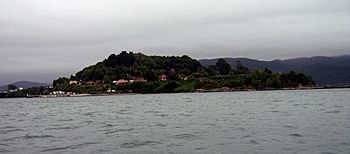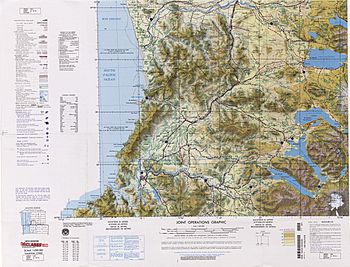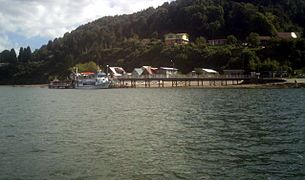Mancera Island facts for kids
|
Native name:
Isla Mancera
|
|
|---|---|

Mancera Island, view from Niebla, Chile
|
|

Regional map
|
|
| Geography | |
| Coordinates | 39°53′26″S 73°23′36″W / 39.89056°S 73.39333°W |
| Adjacent bodies of water | Valdivia River |
| Length | 1,300 m (4,300 ft) |
| Width | 650 m (2,130 ft) |
| Highest point | 89 |
| Administration | |
| Region | Los Ríos |
| Province | Valdivia |
| Commune | Valdivia |
| Demographics | |
| Population | 53 (2002) |
Mancera Island (called Isla Mancera in Spanish) is a small island located at the mouth of the Valdivia River in Corral Bay. It's known for its important historical fort, which once protected the city of Valdivia.
Contents
A Look Back at Mancera Island's History
Mancera Island has a long and interesting past. It played a key role in protecting the important city of Valdivia.
How Mancera Island Got Its Name
Before it was called Mancera Island, the native Mapuche people knew it as Güiguacabin. This name might have meant "whistle" or "maize party." In 1544, a Spanish explorer named Juan Bautista Pastene discovered the island for Spain. He first named it Imperial.
Later, it was called Constantino after its owner, Constantino Pérez. For a short time, it was even known as Santa Ines. The name finally became Mancera. This was in honor of the Spanish viceroy of Peru, Pedro de Toledo, 1st Marquis of Mancera. He was the one who ordered a fort to be built on the island.
Building the Fort: Protecting Valdivia
Construction of the fort on Mancera Island began in 1646. It was officially named Castillo de San Pedro de Alcántara de Mancera, or simply Castillo de Mancera. This fort was a very important part of the Valdivian Fort System.
Together with other forts in Corral and Niebla, the Mancera fort helped protect Valdivia. These forts could crossfire any ship trying to sail up the river to the city. This made it very difficult for enemies to attack Valdivia by sea.
A City on the Island?
In 1682, a big fire badly damaged Valdivia. People suggested moving the entire city to Mancera Island. This idea came up again in 1721. At that time, Spain and Britain were at war, and there was a fear of a British attack.
Because of these plans, some parts of Valdivia actually moved to the island for a while. This led to a boom in population on Mancera Island in the 1700s. Many new buildings made of bricks and wood were built. At its busiest, the fort had twenty cannons. It also had a church and two convents.
The Fort's Later Years
Over time, Mancera Island became less important in the fort system. By 1820, when Corral Bay was attacked by Patriots, the island had only a small group of soldiers. It also had just one battery of six cannons.
See also
 In Spanish: Isla Mancera para niños
In Spanish: Isla Mancera para niños




